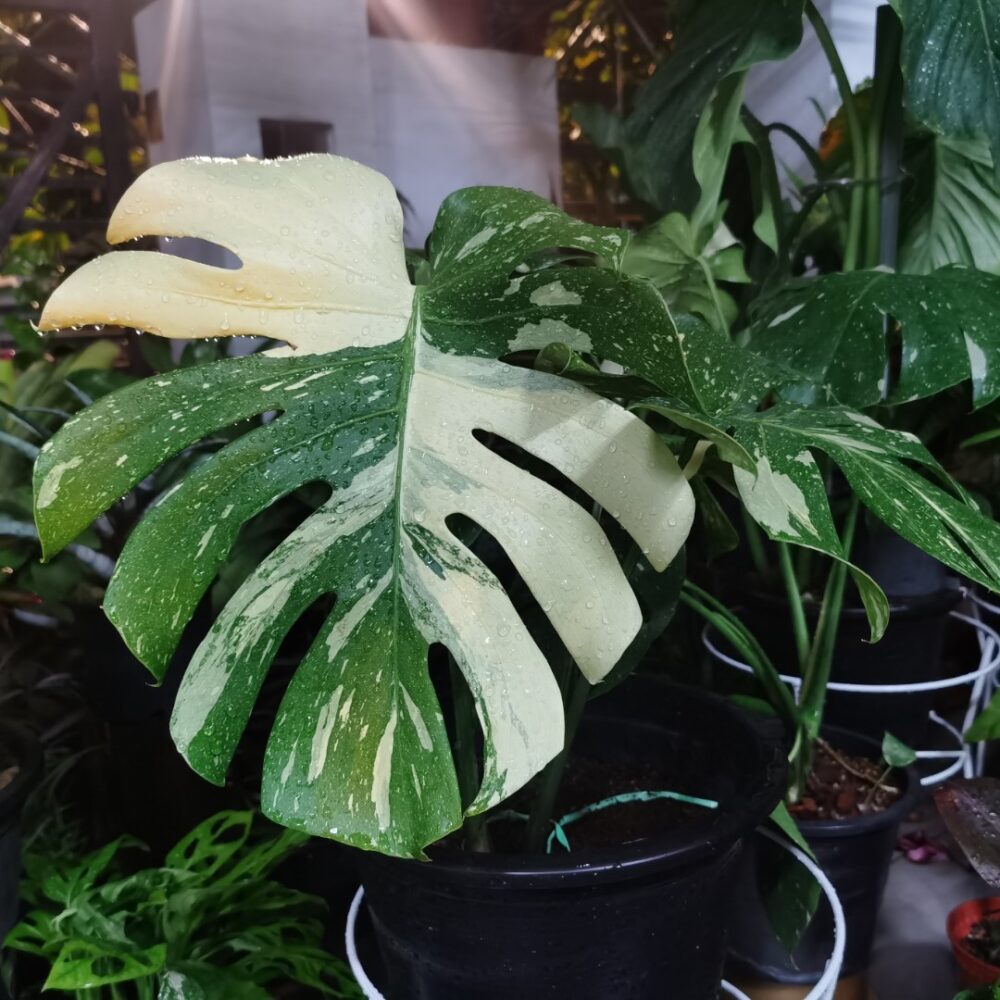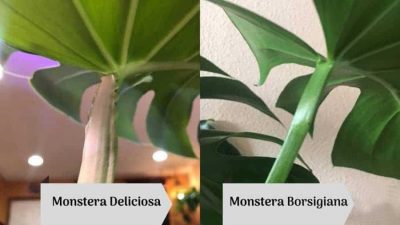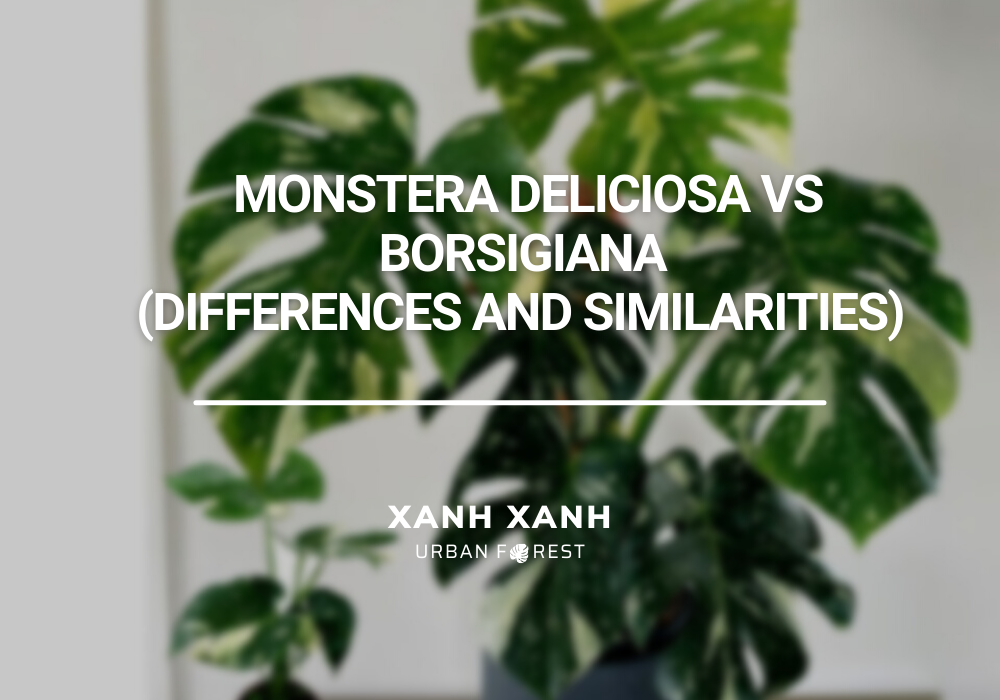Do you want to know the difference between Monstera deliciosa and Monstera borsigiana? Due to its striking resemblance, it’s frequently confused with borsigiana and vice versa.
To avoid this blunder, you must first discover their distinctions in order to distinguish one from the other. By describing certain distinct traits, this article will assist you in recognizing a Monstera deliciosa from a Monstera borsigiana.
Difference Between the Monstera deliciosa Vs borsigiana
Geniculum
The geniculum is one of the most well-known differences between Monstera deliciosa and Monstera borsigiana. The geniculum refers to the stem joint that connects it to a leaf or leafstalk in plants.
At the end of each petiole, where it meets a leaf, Monstera deliciosa possesses a wavy or wrinkly geniculum. Because of their curving texture and look, some people refer to them as “ruffles.” The plant’s unique structure allows for movement and flexibility.
Borsigiana, unlike deliciosa, resembles the other plants with the usual geniculum. When you touch the leaf base that joins it to the stem, it is merely plain and straight, and it feels smooth.
While looking at the geniculum of your plant can help you determine if it’s deliciosa or borsigiana, you can’t tell the difference while they’re young.Deliciosa develops these ruffles as it matures from semi-mature to full maturity.

Growth Habit
Monstera deliciosa grows in a horizontal and widespread manner. This means that they tend to grow and spread in tandem with their surroundings.
Furthermore, because they are slow climbers, you will usually discover them slithering down the earth. However, as the deliciosa matures, it will eventually become a vine.
Borsigiana, on the other hand, has a vining growth habit. Its stem is longer and grows along the ground or up a particular stack.
In comparison to deliciosa, borsigiana begins to climb and twine as a vine during its early stages of development.
It’s more likely to be a deliciosa if your Monstera looks a little messed up, with nesting leafstalk and stem. Meanwhile, it appears that you have a borsigiana if your Monstera has a neater growth pattern.
Stem Structure
Looking at the structure of the Monstera stems will help you figure out what kind of plant it is.
The difference between a Monstera borsigiana and a Monstera deliciosa is the distance between their nodes. The round-like sections or patches that exist between the stems of a plant are known as nodes.
It’s where you’ll find buds, branching twigs, and leaves. It is the point on the Monstera that connects the petiole, which holds the leaf, to the main stem.
When comparing the borsigiana to the deliciosa, you’ll see that the intervals between nodes are much longer in the borsigiana. This is why, as it pushes new growth, borsigiana tends to vine at a higher rate.
So, if your Monstera seems a little haphazard, with the leaves clustered together, you might be dealing with a borsigiana.
However, if your plant’s petioles appear to be scattered and away from one another, it could be the opposite type.
Similarities of the Monstera deliciosa and borsigiana
Now we’ll talk about some of the similarities between Monstera deliciosa and Monstera borsigiana.
Perforated Leaf Structure
Monstera deliciosa and Monstera borsigiana are both well-known for their dark green leaves that look to have been neatly cut with scissors.
The number, size, and appearance of these cuts between leaves might vary. However, they are generally oblong or semi-round in shape.
Leaf fenestration is the precise term for these natural leaf openings. These circle incisions, which run parallel to the leaf’s principal veins, serve to enhance the Monstera’s moisture and nutrient intake.
This is because the Monstera vine’s roots and roots struggle to acquire enough water.
Furthermore, Monstera produces perforated leaf structures as a response to rainfall and wind pressure.
The openings allow rain to fall through and directly onto the roots. They also provide some protection from wind harm to the plant.
The holey leaves are a distinguishing feature of both Monstera deliciosa and Monstera borsigiana.
However, keep in mind that these changes occur as the plant ages. For a while, the leaves of the younger Monstera may appear smaller and virtually uncut.

Leaf Shape
Though Monstera deliciosa leaves are always larger than Monstera borsigiana leaves, their leaf form is comparable.
These Monstera, which belong to the same genus as the blooming plants in the Arum family, have cordate leaves.
The leaves are shaped like a heart, with a deep cut base that extends to a broad, flat surface with a tapering apex.
Despite the holes going from the center to the leaf margins, it still looks like a heart.
Monstera deliciosa and Monstera borsigiana have heart-shaped leaves in general, though some may not be perfectly cordiform.
Root System
Monstera deliciosa and Monstera borsigiana have the same root structure, in addition to having similar leaf characteristics. They both produce a large number of aerial roots, which are also known as adventitious roots.
Aerial roots are those that grow above the growing medium or earth, either down from the stem or up the primary roots.
Moisture absorption, nutrition uptake, air exchange, and proliferation are all processes performed by aerial roots.
Typically, the Monstera is planted in the ground and then gradually grows up, showing its aerial roots.
Do you know what an orchid is? Monstera, either borsigiana or deliciosa, uses its roots to move up the ground in the same way that orchids do.
The roots are robust and flexible enough to cling to supporting structures like trees, rocks, and buildings.
Keep in mind that either Monstera deliciosa or Monstera borsigiana grows aerial roots over time. When a result, as the plant matures, you may only notice the roots growing up a great distance in the air to the earth.
Here’s what you need to know about Monstera deliciosa and Monstera borsigiana. These will help you distinguish one from another, despite the fact that they appear to be extremely identical in many ways.

